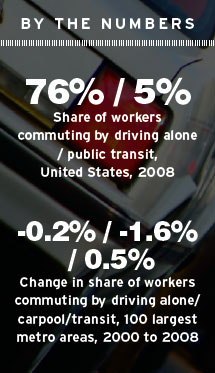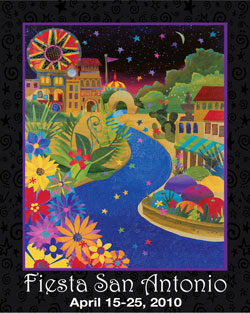Passenger rail Transit: commuter rail light-rail
by Brian
Comments Off on The difference between commuter rail and light rail (redux)
The difference between commuter rail and light rail (redux)
I wrote about this back in 2010, but I feel it needs a revival after seeing yet another story in the local media referring to the once-proposed rail project between San Antonio and Austin as “light rail”. This is incorrect– that project, known as Lone Star Rail or “L-Star”, was to be a commuter rail line, not light rail. It’s not just semantics– there is a big difference in the two. Unfortunately, “light rail” continues to be a buzzword that people around here use without fully understanding what it actually means.
Commuter rail typically uses large, Amtrak-style trains running at fairly high speeds on completely dedicated right-of-way with limited, widely-spaced stops and schedules more oriented to twice-a-day commuters, meaning midday and weekend service is infrequent or even non-existent. This was the type of service planned between San Antonio and Austin. The TRE train between Dallas and Ft. Worth is an example of such service here in Texas.

TRE commuter rail
Light rail (LRT), on the other hand, uses smaller, lighter trains (thus the term “light” rail) that more closely resemble large streetcars than they do “regular” trains, run at somewhat slower speeds, often run in dedicated rights-of-way but sometimes run on streets, have rather closely-spaced stations or stops, and have fairly frequent schedules and short headways (time between trains) all day long. This is likely the type of rail service that would be built by VIA in San Antonio if they build a rail line someday although there has been some discussion of building a commuter rail route using the rail line between downtown and the RIM. DART in Dallas and Metro in Houston are examples of LRT in Texas.
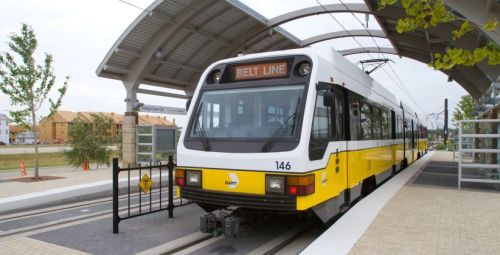
DART light rail
Some other differentiations: Commuter rail trains are much longer than LRT trains and connect the central city to the suburbs while LRT trains typically run mostly within the main urban area (in San Antonio, that would be within Loop 1604.) Also, commuter rail trains are frequently diesel-powered, while LRT trains are almost always electric-powered.
Of course, just to confuse things, there are exceptions, including one just 70 miles up the road (or track as it were): Austin’s MetroRail commuter rail service uses diesel-powered LRT-style trains for what is actually a commuter rail service.
Hopefully this will put an end to the frequent misuse of “light rail” around here to refer to the possible rail service between SA and Austin, although I doubt it.
If you want to learn about the different types of rail systems, Wikipedia has a nice overview here. Denver’s RTD also has a nice write-up. And see “How does commuter rail differ from light rail and heavy rail?”
Commuting Roads Transit: HOV lanes I-10 Texas Department of Transportation US 281 widening
by Brian
Comments Off on Not gonna use the HOV lane? It still benefits you!
Not gonna use the HOV lane? It still benefits you!

TxDOT is preparing to build San Antonio’s first two high-occupancy vehicle (HOV) lanes on I-10 West and US 281 North. Construction of both is scheduled to start this year.
One comment I frequently hear about HOV lanes is from people saying they won’t use them, so they won’t benefit from them. A corollary of that is that people who won’t use them don’t think their tax money should be spent on them. As is often the case, both of these viewpoints fail to see the bigger picture.
Data visualizations Gas taxes Laws and policies Roads Transit
by Patrick
Comments Off on Texas drivers help pay tab for roads in other states
Texas drivers help pay tab for roads in other states
When you look at how much Texas drivers hand over to Washington and how much comes back, it’s easy to feel like the feds don’t like us much.
Federal officials do not “directly” return a whopping 78 percent of fuel and vehicle taxes collected in Texas. That’s second highest among states; behind Iowa with its 84% bye-bye rate and well ahead of third-place Florida.
Unfortunately, though, there’s a bigger untold story here. Officials invested more than half of those collections into projects straddling one or more states. And the data doesn’t show how those amounts were distributed among states.
So the 78% no-return likely isn’t as bad as it looks. Texas probably received more. Still, hover over the interactive map above and you’ll see a wide range of give and take, including Alaska’s 60 percent gain.
The data, from fiscal 2011, is the latest from the Federal Highway Administration. I saved it to a CSV file and used D3.js, with an assist from ColorBrewer.js and some custom javascript, to display it here. Have fun.
Commuting Gas taxes Oil and gas prices Passenger rail Roads Transit: congress
by Patrick
Comments Off on What’s ahead for gas prices, taxes and roads
What’s ahead for gas prices, taxes and roads
You’ll likely pay more than $3 a gallon for gas next spring.
But you’ll probably keep paying the same 18 cents per gallon federal gas tax — which has lost more than a third of its purchasing power since it was last raised in 1993.
The roads you drive on will get worse. Transit will face ongoing challenges.
That’s what appears in the fog ahead as Republicans take back the U.S. House amid the worst financial crisis since the Great Depression. Feeding voter sentiments are widespread fears about rampant spending and taxing.
Incoming Transportation Committee Chairman John Mica of Florida told reporters last week that the gas tax will go nowhere — which mirror’s President Obama’s position — and that he wants to reconsider recent high-speed rail grants.
But Mica also said he’ll grab hold of a stalled $500 billion six-year transportation reauthorization bill, now a year overdue, and work to push it through. The bill is twice as much as the 2005 law and twice as much as what the gas tax will bring in.
Even so, the massive bill still falls some $150 billion short of just being able to maintain what we have, indicates a report headed by two former U.S. transportation secretaries. And that’s just the federal gap — states and local entities have holes too.
We are facing an “elegant degradation” of our transportation system, the report warns. It will be slow, sure and very costly.
SOURCES:
- Federal gas-price predictions
- St. Augustine Record report
- Reuters report
- New York Times report
- Well Within Reach report
OTHER STUDIES:
Commuting Parking Passenger rail Railroads Transit Travel
by Hugh
Comments Off on Passenger rail in Asutin and San Antonio
Passenger rail in Asutin and San Antonio
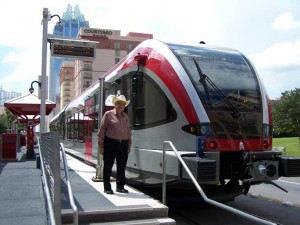
Larry Walsh and the Austin MetroRail
My friend, Larry Walsh, and I finally found the time last Tuesday, July 27, to make a visit to Austin’s new commuter rail line, Capital MetroRail. This is what is hoped to be the first thirty miles of a city wide system. This first section runs from the city center at 4th and Trinity to Leander, a commuter colony way to the north of Austin itself. more »
Bicycling to downtown San Antonio on a summer day
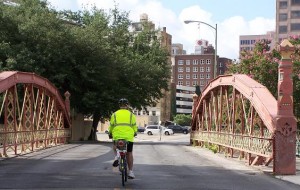
Augusta Street bridge, San Antonio
My wife and I spent some five hours out and about on our bikes yesterday, heading downtown from our house near Red McCombs Ford outside Loop 410 to the King William district. Altogether it came to a trip of 22.35 miles, mostly along San Antonio’s old main thoroughfares, San Pedro Avenue and Fredericksburg Road. We set of around 8:00 AM, when it was only 80 degrees and got back just before 1:00 PM, when it was well over 90. more »
See how San Antonio plans to make its buses perform like light rail
Can buses look and operate more like light rail?
VIA Metropolitan Transit officials think so. And now the public can peek under the hood of a plan to spend $57 million to speed up bus travel and make trips more comfortable along Fredericksburg Road.
The agency will hold three public meetings over two weeks to explain the latest on an environmental study:
Monday, May 24
6 p.m.
Jefferson High School cafeteria
723 Donaldson
Thursday, May 27
1:30 p.m.
Norris Conference Center
Wonderland of the Americas Mall
4522 Fredericksburg Road, Suite A100
Thursday, May 27
6 p.m.
Norris Conference Center
Wonderland of the Americas Mall
4522 Fredericksburg Road, Suite A100
The study says buses could scoot along 30 percent faster on nine miles between downtown and the Medical Center, two prime job centers anchoring one of VIA’s busiest routes. More than a fourth of the area’s 79,000 residents depend on transit.
The cost for bus rapid transit, as it’s called, includes traffic signal controls to give buses more green time, faster ticketing, sidewalk-level boarding, two roomy transit centers and eight enhanced stations. The hope is that developers will create walkable, mixed-used hubs around the stops.
The cost does not include dedicated bus lanes on part of the route, as proposed in previous plans that put the tab at around $100 million.
Construction is supposed to start this year, with service starting in late 2012.
LINKS:
Commuting Passenger rail Transit
by Patrick
Comments Off on One in four commuters are part of this growing national trend
One in four commuters are part of this growing national trend
One in four big-city commuters walk to work, ride bicycles, use transit or at least share car rides with other workers, a new study says. A good number even stay home to work.
In other words, 24 percent of Americans in the 100 largest metro areas don’t drive solo to work, according to “The State of Metropolitan America,” a report released this week by the Brookings Institution.
And though a whopping three-fourths still drive alone, that portion has been shrinking, says the report’s 12-page commuting chapter.
From 2000 to 2008:
TRANSIT RIDERSHIP: went up for the first time in 40 years, reaching 5 percent in 2008, though that’s still shy of 5.1 percent from 1990.
DRIVING SOLO: slid down slightly, mostly in 2007 to 2008, the first year of the Great Recession and a time of shockingly high gas prices. Austin led the nation’s biggest cities with a 3.6 percent drop.
CARPOOLING: dropped to 11 percent, less than the 12 percent from 1970.
TWO-WHEELING: by bicycle and motorcycle rose slightly, to 1.7 percent.
WALKING: declined to 2.8 percent, down from 7.4 percent in 1970.
TELECOMMUTING: jumped to 4.1 percent.
The report breaks down the trends by demographics and geography and mentions some other notable Texas numbers:
El Paso is third in the U.S. for a 3.2 percent increase in solo driving and second for a 5.2 percent decrease in carpooling; McAllen ranks in the top five for both the percentage of commuters who carpool and those who quit carpooling; and Houston is fifth for loss of transit share.
LINKS:
Laws and policies Roads Transit: MPO public meeting
by Brian
Comments Off on MPO holding public meetings for 4 year plan
MPO holding public meetings for 4 year plan
 The San Antonio-Bexar County Metropolitan Planning Organization (MPO) will be holding three public meetings on its 2011-2014 Transportation Improvement Program (TIP). Essentially, this is the revolving list of local transportation projects that are proposed to be funded* over the next three four years (yes, I can count <g>). The projects selected are typically a subset of those in the current long-range plan. Obviously, what eventually does get funded depends heavily on what money eventually comes to this area, but this plan identifies the projects that are first in line to get whatever funding becomes available. The plan includes allocations for all forms of transportation including highways, streets, transit, and bike and pedestrian amenities.
The San Antonio-Bexar County Metropolitan Planning Organization (MPO) will be holding three public meetings on its 2011-2014 Transportation Improvement Program (TIP). Essentially, this is the revolving list of local transportation projects that are proposed to be funded* over the next three four years (yes, I can count <g>). The projects selected are typically a subset of those in the current long-range plan. Obviously, what eventually does get funded depends heavily on what money eventually comes to this area, but this plan identifies the projects that are first in line to get whatever funding becomes available. The plan includes allocations for all forms of transportation including highways, streets, transit, and bike and pedestrian amenities.
The MPO is the agency charged under state and federal law to control the transportation funding purse-strings for the San Antonio urban area, which in this case includes Bexar County and portions of Comal and Guadalupe counties in the Schertz area. The TIP is required under federal regulations as a condition of receiving federal funding. Projects not in the TIP cannot use federal funds, so this is an important process.
There will be three meetings, all with identical content:
- Tuesday, May 4th from 5:00 p.m. to 8:00 p.m.
- Thursday, May 6th from 11:30 a.m. to 1:30 p.m.
- Saturday, May 8th from 9:00 a.m. to noon
All three will take place at VIA Metro Center on San Pedro just south of SAC. Visitors will also be able to check-out some new interactive systems and discuss the transportation planning process with the folks that make these decisions.
For more information and to see a draft copy of the TIP, click here. Also, see the interactive site here (link added 5/4/10 10:35 am).
(* As I’ve discussed before vis-a-vis the US 281 project, the term “funded” in transportation parlance means that anticipated revenues during the plan timefame will be able to fund a project. Until those revenues are actually allocated to the MPO, a project does not actually have money available to start work.)
Parking Roads Safety Transit: Fiesta
by Patrick
Comments Off on Five things to know before heading to Fiesta events
Five things to know before heading to Fiesta events
Soggy skies put a damper on the start of the year’s biggest party, with officials cancelling tonight’s Fiesta kickoff at Alamo Plaza and moving the opener to Market Square tomorrow. Hope you didn’t head out to Alamo Plaza.
No worries about the revelry cranking up. It will. But before joining the fun, here are some things to check on:
PARKING: Even tested downtown drivers can lose a little focus when Fiesta fills up parking lots and kicks up parking fees. The Express-News has a decent map of parking lots, but alas, doesn’t include fees. MAP
EXPRESS BUSES: Avoid parking altogether by hopping on special Fiesta express buses. VIA set up an event page with details, which includes reroutes of regular services due to street closures. FIESTA BUSES
DRINKING: If you drink, have a drinking and NOT driving plan. The easiest thing to do is assign a designated driver. In a pinch, Yellow Cab will provide up to 700 free rides for certain events, thanks to a state grant. Of course, you can always fork out your own $25 for a cab, and it’ll be a lot cheaper than a $17,000 DWI fine. CALL 222-2222
TRAFFIC: Make it easy on yourself. Just a few minutes checking TransGuide’s site for wrecks and slowdowns can save you an hour on the highway. TRANSGUIDE
WEATHER: Nuff said on that. FORECAST
Now go have a great time. And be safe.
More links:


